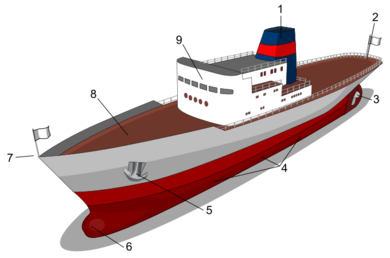Gross tonnage facts for kids
Gross tonnage (often called GT) is a way to measure the total inside space of a ship. It's not about how heavy the ship is, but how much room it has inside. Think of it like measuring the total volume of a big box. It's different from other ship measurements like gross register tonnage or how much the ship weighs (like deadweight tonnage or displacement).
GT was created by an international agreement in 1969, called the International Convention on Tonnage Measurement of Ships. This agreement was put together by the International Maritime Organization (IMO). It became official on July 18, 1982. GT and another measure called "net tonnage" replaced older ways of measuring ships. GT helps decide important things like how many crew members a ship needs, what safety rules it must follow, how much it costs to register the ship, and fees for using ports.
Contents
Understanding Ship Measurement History
For a long time, different countries used different ways to measure ships. This made things confusing for international shipping. So, in 1969, the International Maritime Organization (IMO) created a new, worldwide system. This new system introduced Gross Tonnage (GT) and Net Tonnage (NT). It was the first time everyone agreed on how to measure ships.
Before this, many different methods were used to measure ships. One of the earliest ideas came from George Moorsom in Great Britain in 1854. But these old methods were not the same everywhere.
The new rules for GT and NT apply to all ships built on or after July 18, 1982. Ships built before that date were given 12 years to switch from their old measurements to GT and NT. This change period allowed ship owners time to adjust their plans, because these measurements affect many costs and rules. One main goal of the new system was to make sure the new GT numbers were similar to the old ones.
Both GT and NT are found by measuring a ship's volume and then using a special math formula. Gross tonnage looks at the total volume of all the enclosed spaces inside the ship. Net tonnage, however, only looks at the volume of the spaces used for cargo. Also, a ship's net tonnage must always be at least 30% of its gross tonnage.
How to Calculate Gross Tonnage
The way to calculate gross tonnage is explained in the International Convention on Tonnage Measurement of Ships, 1969. It uses two main numbers:
- V: This is the ship's total volume in cubic meters (m3).
- K: This is a special number that changes based on the ship's volume.
The value of K gets bigger as the ship's total volume increases. It's like a multiplying factor. You find K using this formula:
Once you know V and K, you can calculate gross tonnage using this simple formula:
So, if you put it all together, the formula for GT looks like this:
This means that as a ship gets bigger, its gross tonnage grows faster. The units of gross tonnage don't have a simple physical meaning, but they were chosen to be useful for historical reasons.
Images for kids
See also
- Compensated gross tonnage
- List of world's largest ships by gross tonnage
- Ton
- Tonnage






